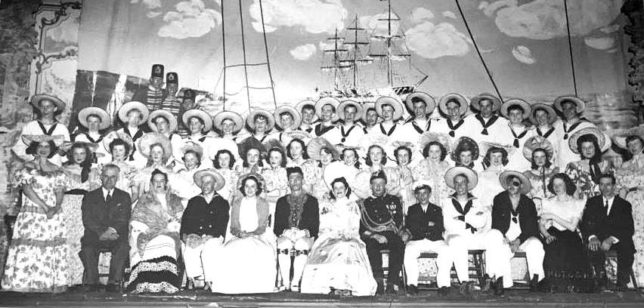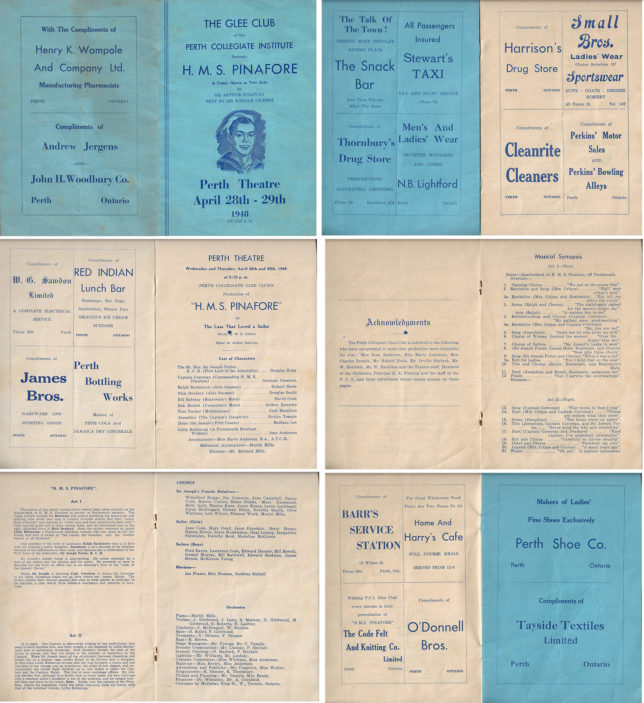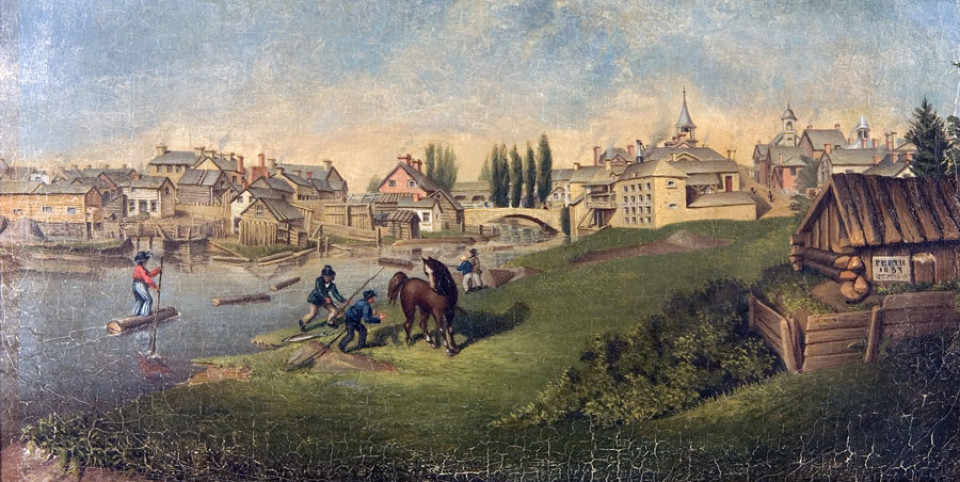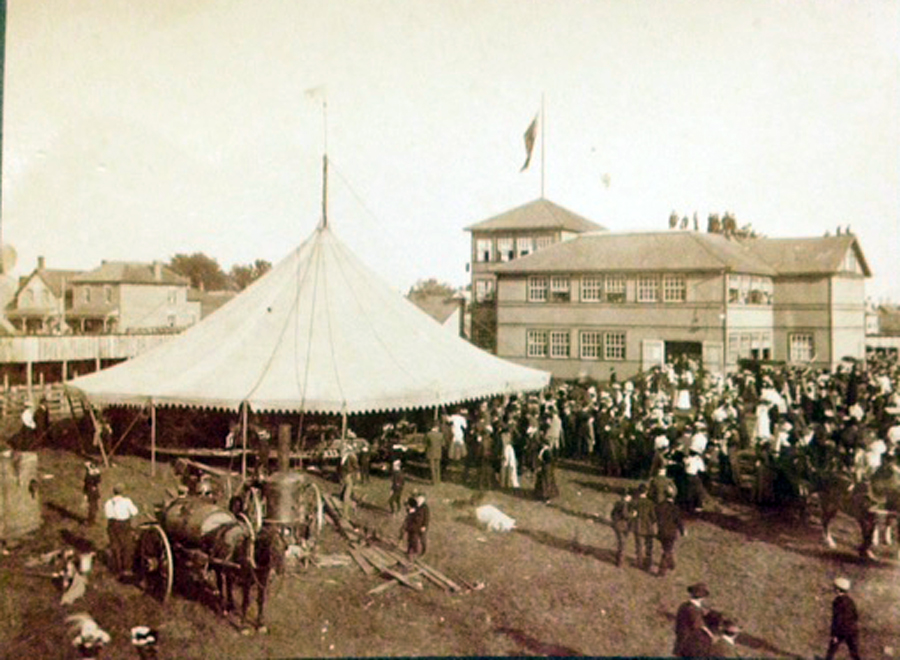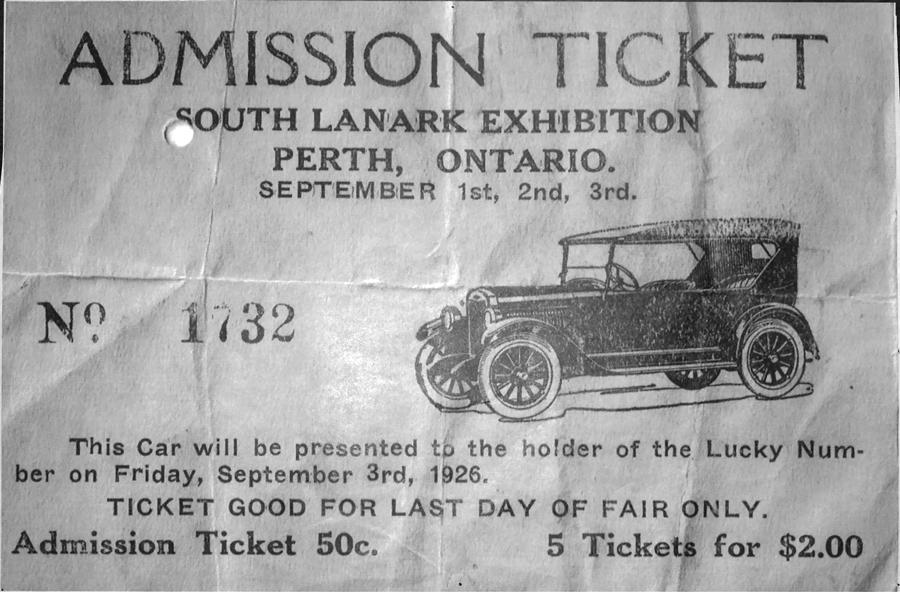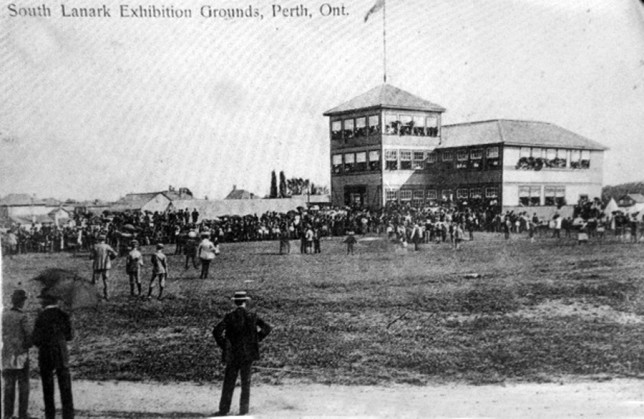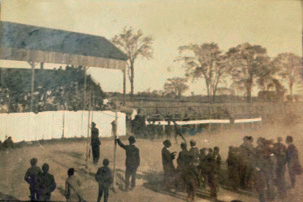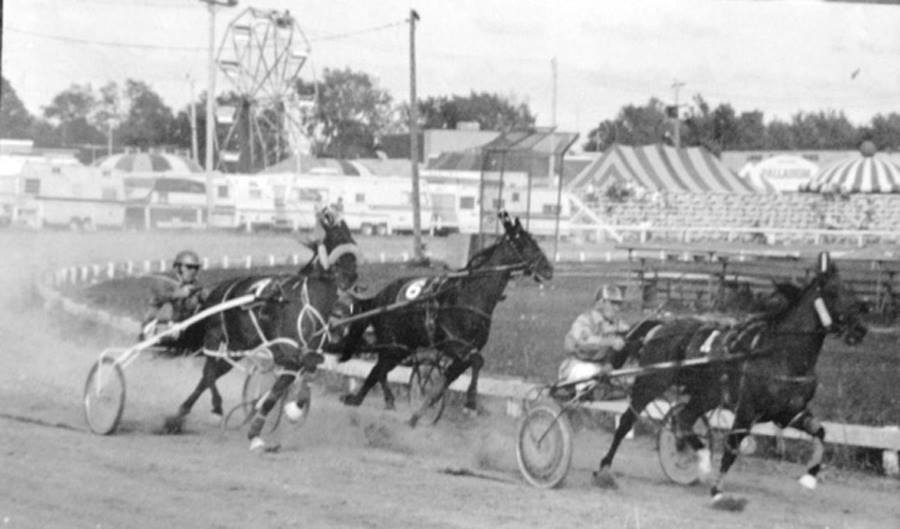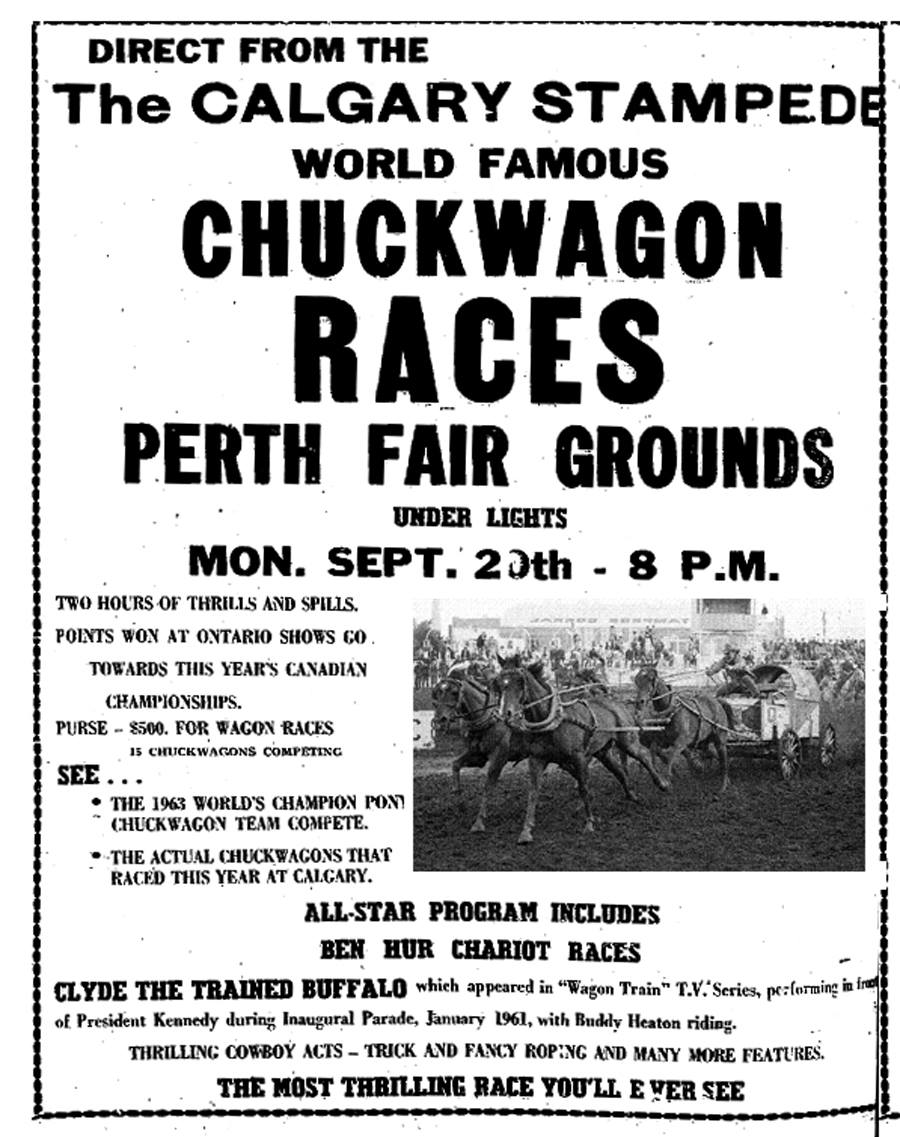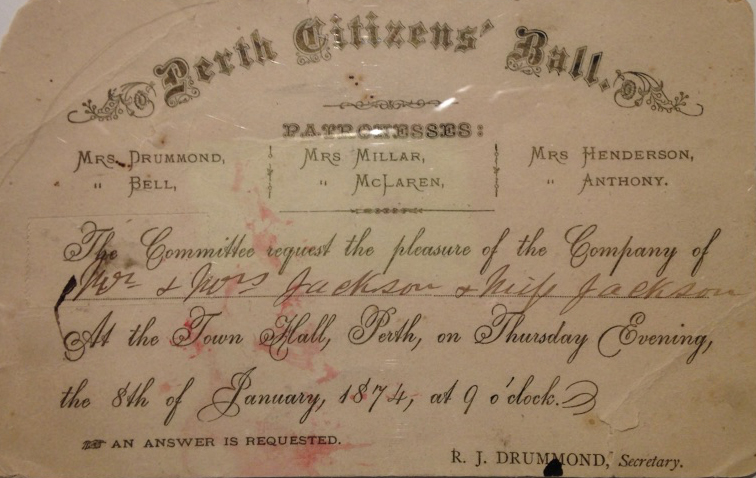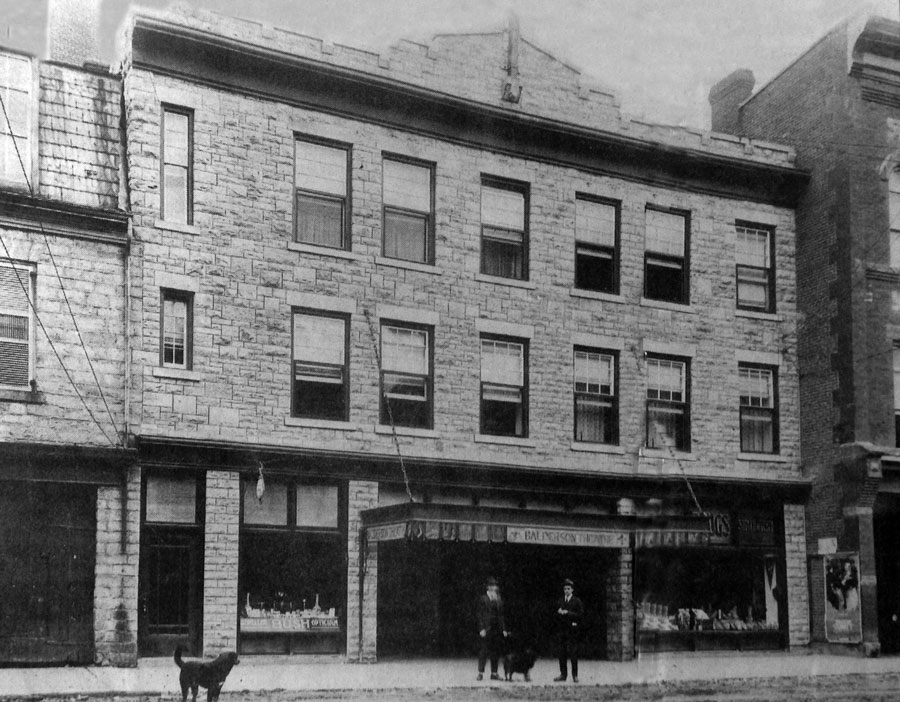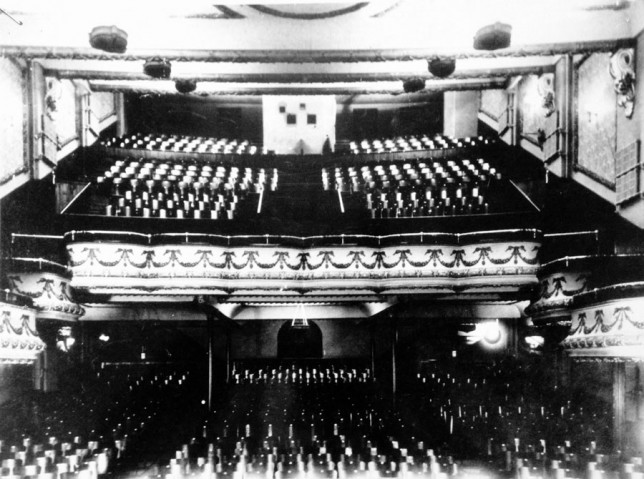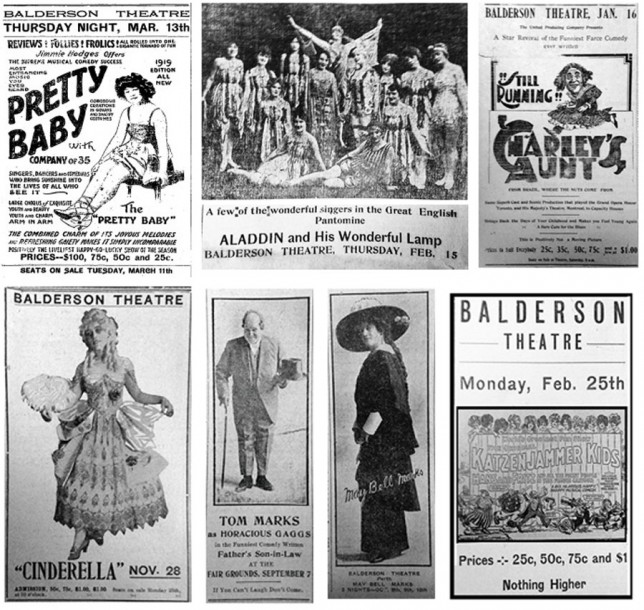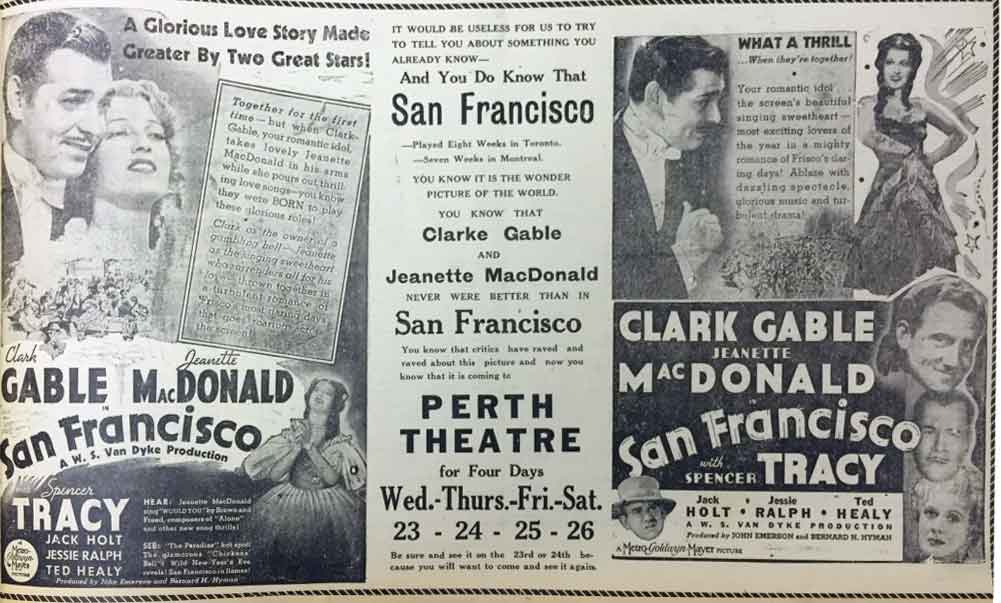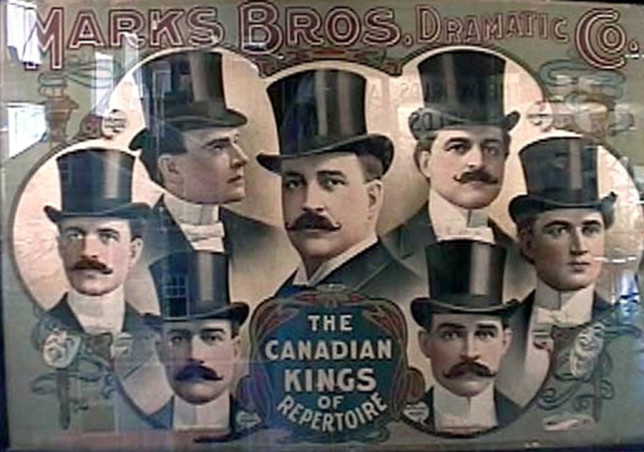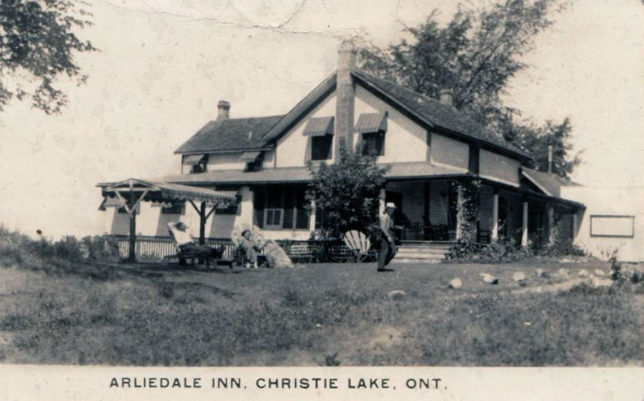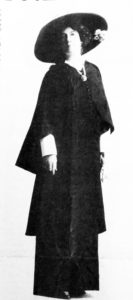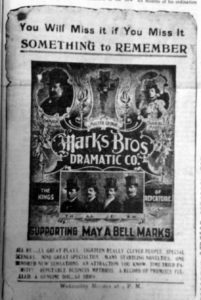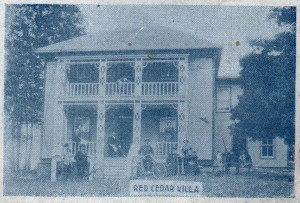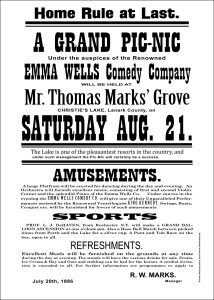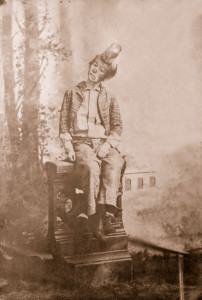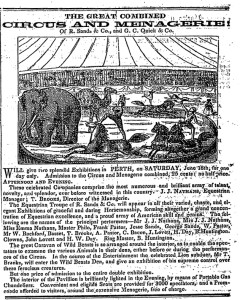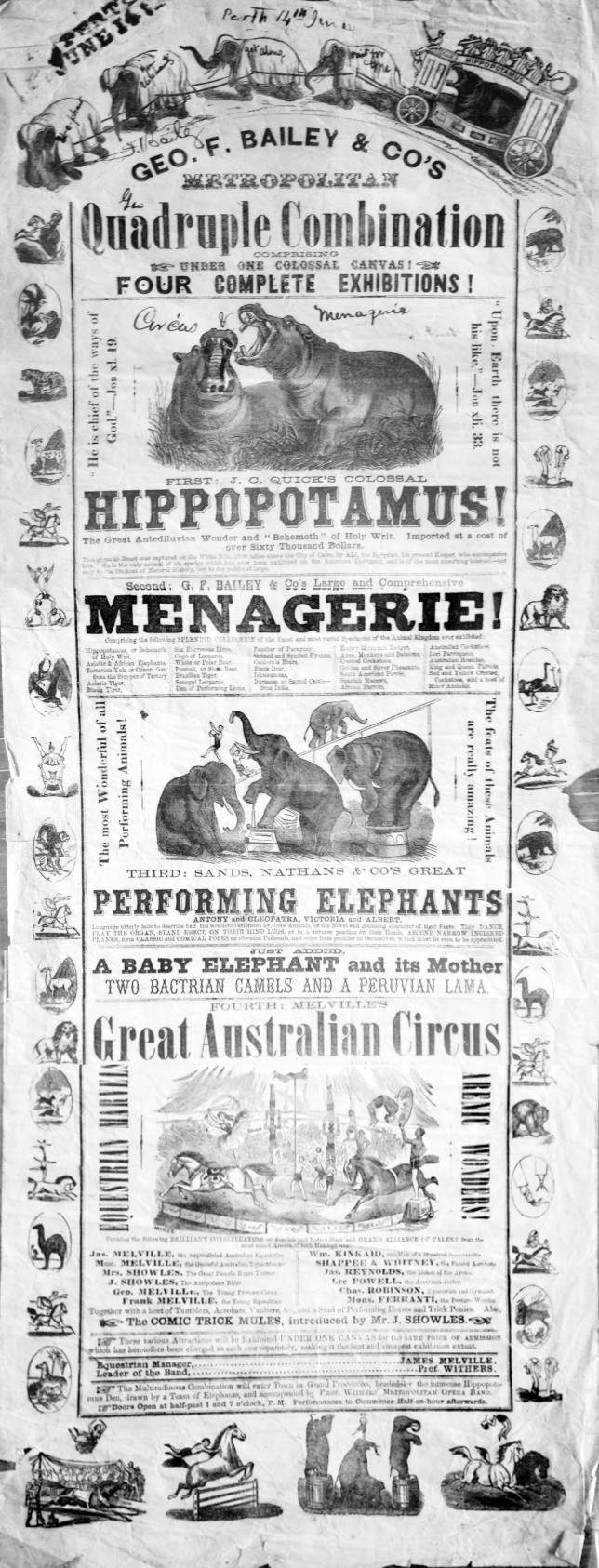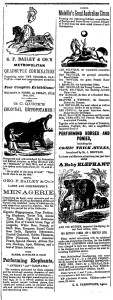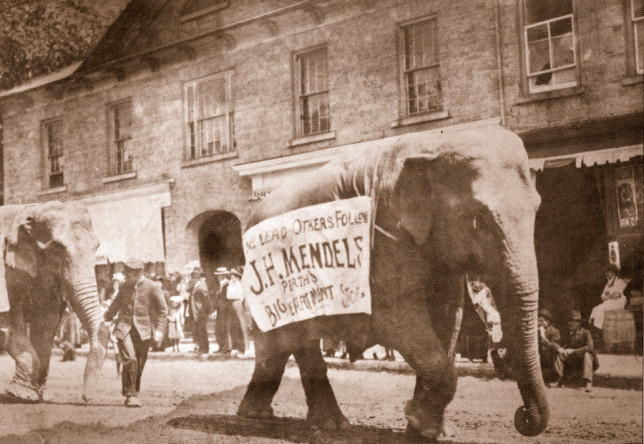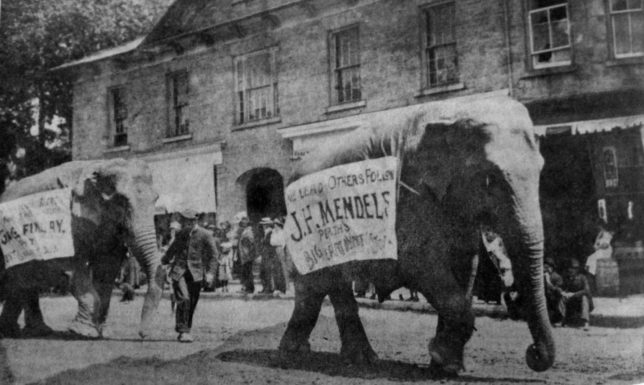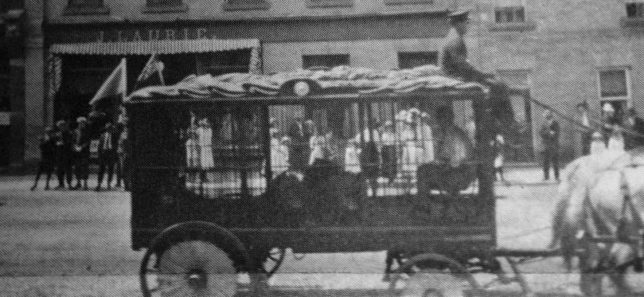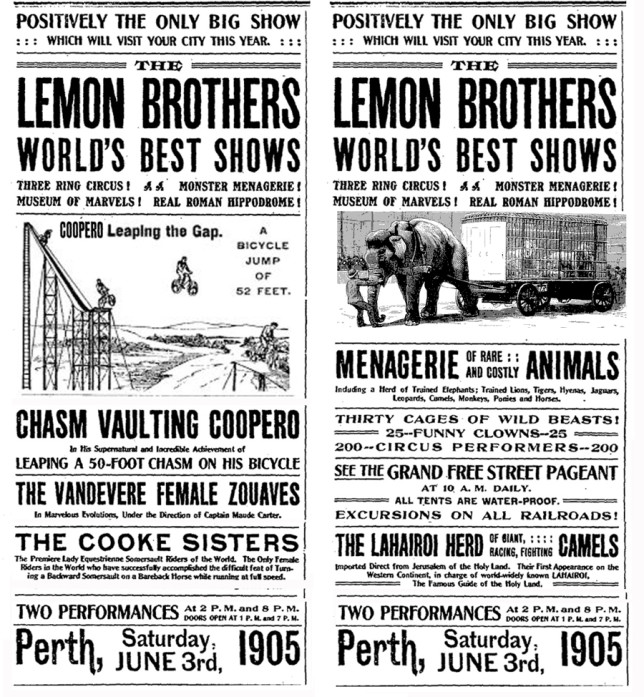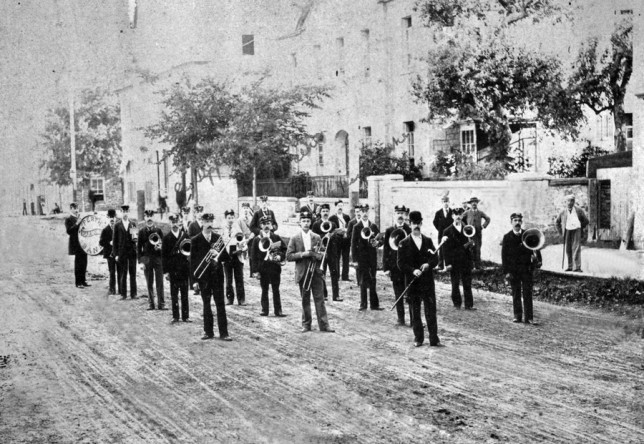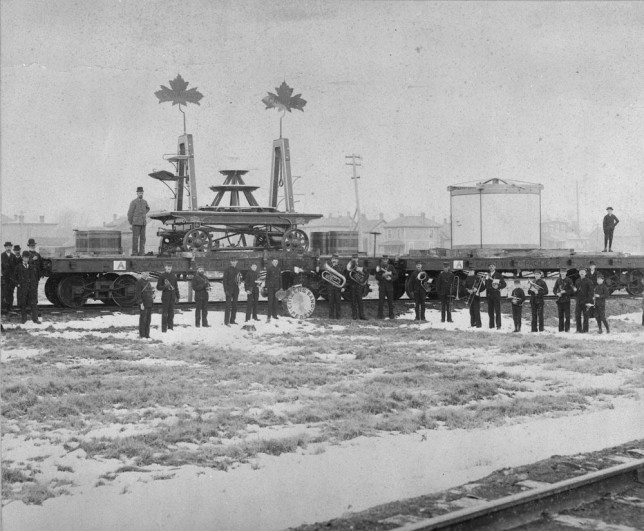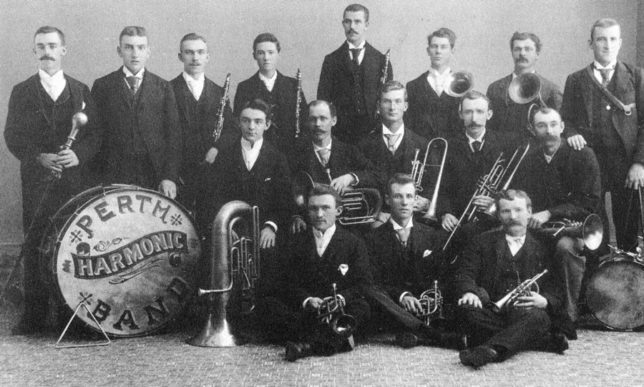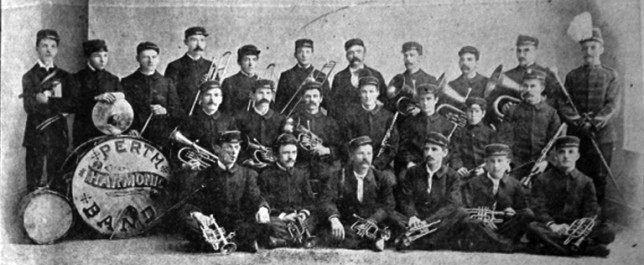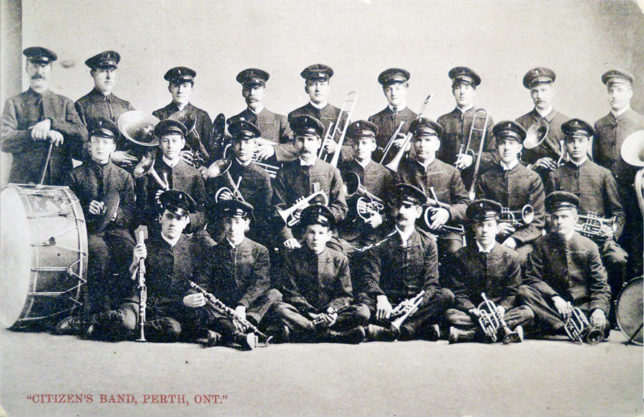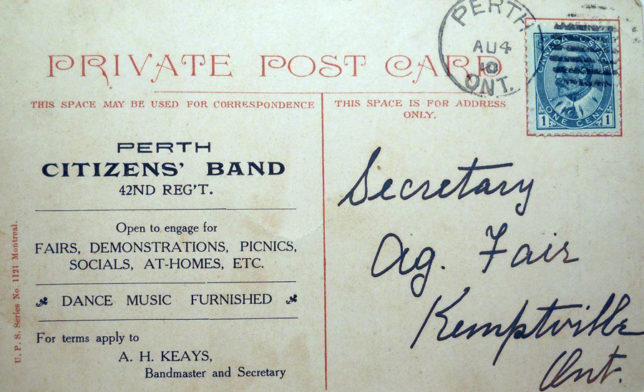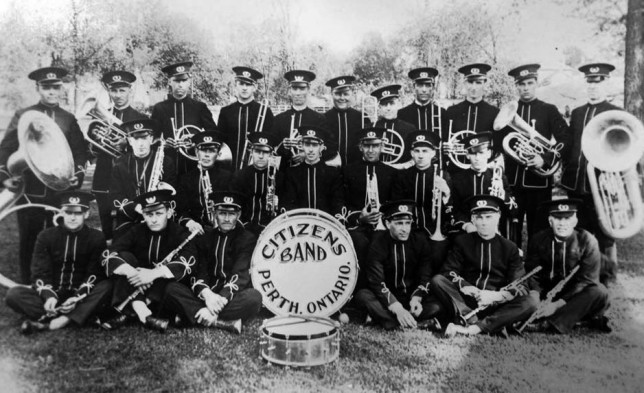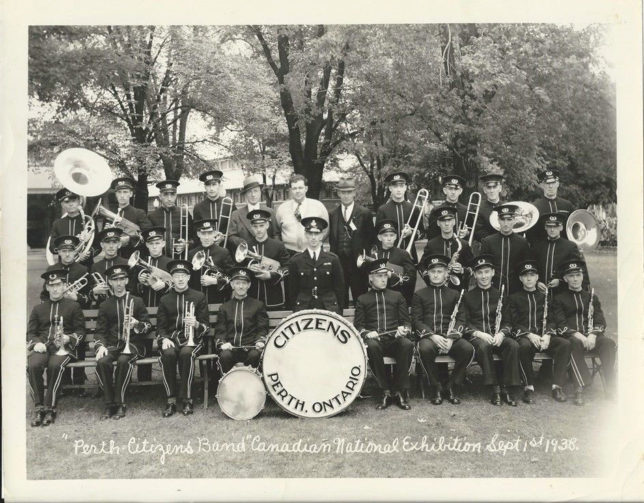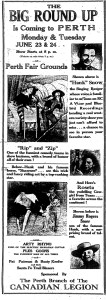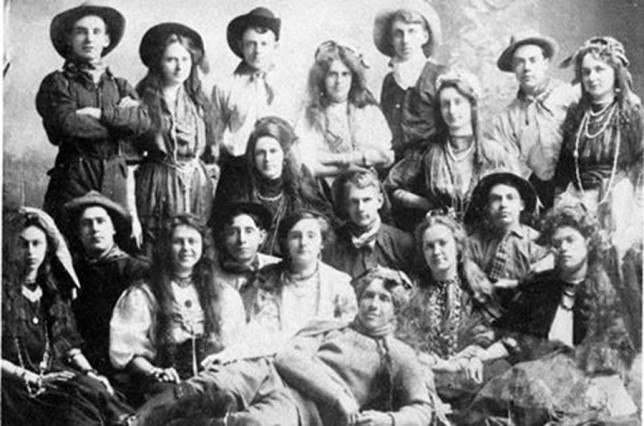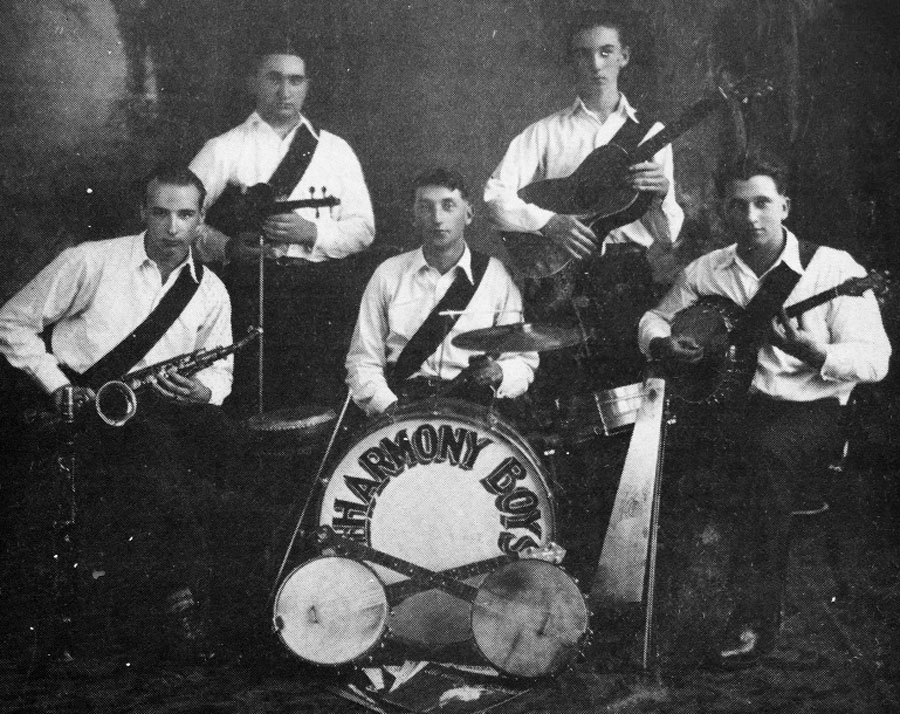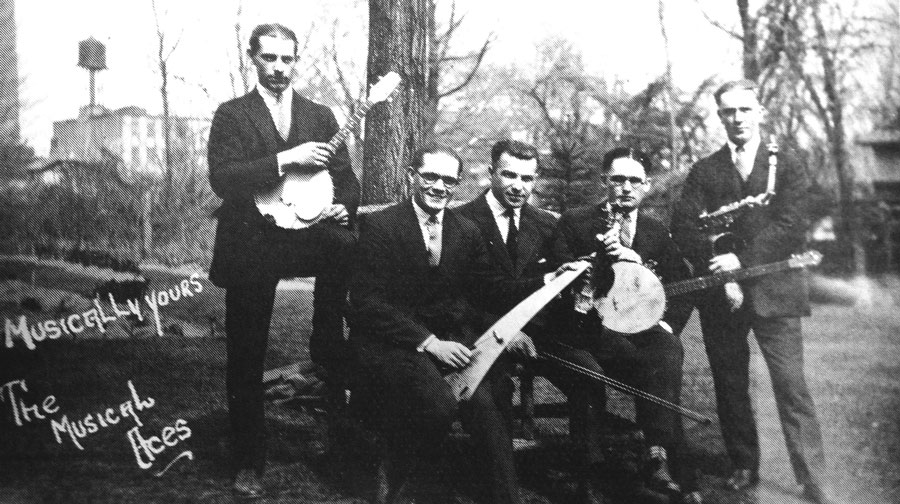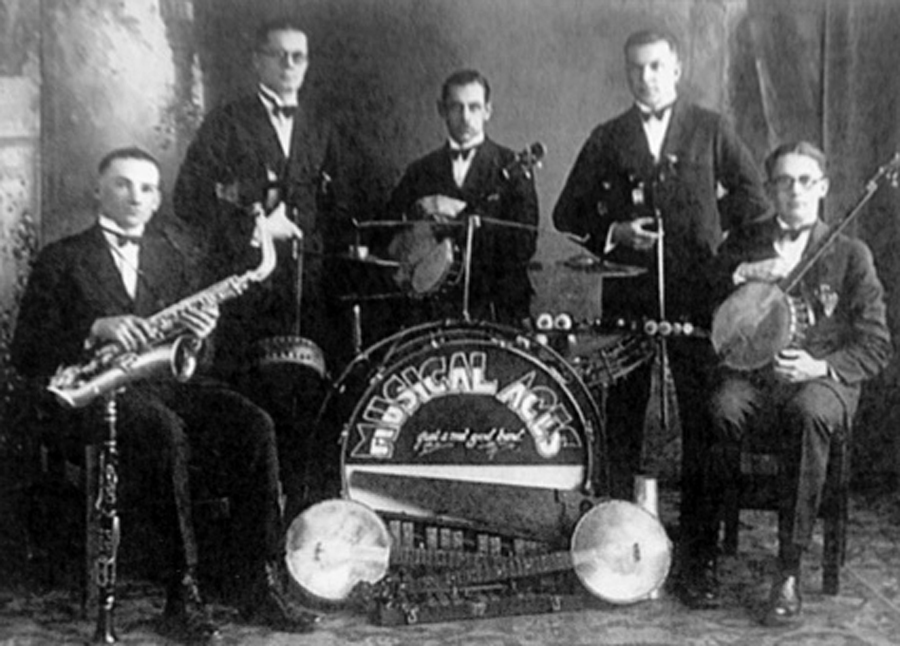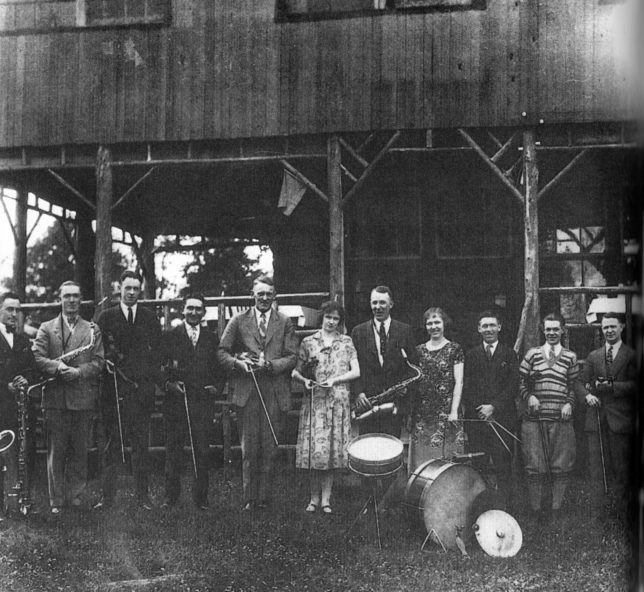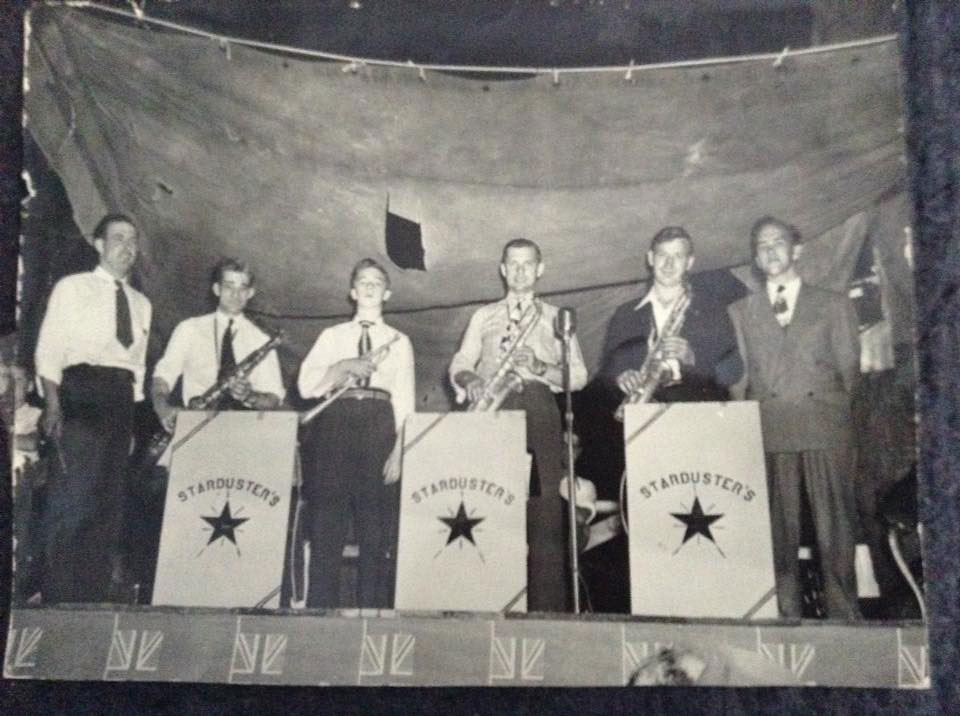THE PERTH FAIR 1835
THE PERTH FAIR – September 2nd, 1954 – The Perth Courier
1817, a year after the town of Perth was founded, was one of great hardships and privation. The crop of potatoes was destroyed by frost and rust ruined the wheat crop. Some families were forced to live on wild leeks and other herbs found in the woods until the Government came to their aid with additional half rations and averted famine. In spite of all these hardships and rigors of carving a home from the vast Canadian wilderness, these early pioneers found time to give thought to the improving of their live stock and their community. According to a newspaper clipping of 18138, an organization known as the Perth Agricultural and Live Stock Improvement Society, was organized which offered the services of a recently purchased horse of outstanding quality. It is not know exactly when this society was formed but in the July 11th issue of 1843 of the Bathurst Courier had a report of a director’s meeting of the “Perth Agricultural Society”. In 1846 the society was reorganized and renamed the South Riding of Lanark Electoral District Agricultural Society. Fortunately this awkward and unwieldy title was soon shortened to the South Lanark Agricultural Society.
The location of the first Fall Fair has apparently been lost in the lapse of time as no definite record has so far been located. In 1852 records show that the fair was held at the Town Hall and the Market and lands around the building. All prizes were listed in pounds, shillings and pence. Among the classes to be exhibited were: Best span of working horses – 1st – £1, 2nd – 10s – Best yolk of oxen over 2 years of ages – 1st £1, 2nd-15s – Best 20lbs of clover seed 1st 15s, 2nd 10s and Best bushel apples – 1st 5s – 2nd 3s.
The first real home came in March of 1874 when the society purchased 7.5 acres of ground at a point just north of what is now the junction of Highways 7 and 15 know locally as Greenlee’s Corners. Here they erected a number of buildings.
By 1882 the society had progressed to the point where a premium list and regulations for the annual exhibition to be held at Perth, September 27, 28, and 29 was issued in booklet form with classes for live stock, fruits, flowers, vegetables and handicrafts.
As the grounds were a considerable distance from the town proper the directors of that time considered that it would be to the advantage of the society to dispose of the property in favour of a location nearer to the centre of town, As a result a new site, west of Wilson Street was purchased in July of 1891 the former ground being sold.
In a few years, however, it was decided that the new grounds were too small, so these in turn were sold and converted into a housing project, following the purchase of the present grounds at the southern boundary of the town in May of 1912. This site equipped with an excellent half-mile track had been the scene of many athletic events. The Agricultural Society immediately proceeded to erect buildings.
With information gathered from the diaries of the early settlers, one can almost picture those first Fair days. The early morning stillness broken by the squealing of the wooden wheeled potash carts of the new settlers as they bounced and jolted their protesting way along the Rockeby road. Travelling all night or stopping at the home of some friend along the way, they were always among the first to arrive, ready to exchange their loads of potash with G.S.B. Roberts or some other merchant for groceries or dry goods and a little change to take in the Fair.
All through the morning farm wagons kept rumbling into town, Father, Mother and the youngest perched upon the high pole seat, while the other children, along with two or three of the neighbors rode in the box upon a thick carpet of marsh hay, their noisy babble adding a certain air of festivity to the occasion. Every once in a while the son of one of the older established and more prosperous farmers would pass with his girl, on the way to the fair, the new side spring buggy or two wheeled gig, drawn by a fast horse, the pride of the owners heart.
Around 10 o’clock in the morning the oldest boy, ably assisted by one or two neighbor lads of around the same age (for persons necessary to deliver live stock shalt be admitted free), began to arrive leading, pushing, driving or hanging on to some reluctant member of the animal kingdom. In fact, it can be gathered from the accounts, that persons with a broader sense of humor, had more fun watching the arrival of some of these exhibits than at the fair itself. What with McCallum’s Tavern “setting up the good stuff”, and William Lock’s Brewery offering malt whisky at 4 shillings gallon, it is safe to assume that some at least partook freely. Many of older members of the community can still recall the horse races on to create a diversion, or a spirited way home from Perth Fair. Neck and neck, wagon or democrate bounding on the cobblestones; it was take to the ditch and let them pass, or be run over.
Yes, Perth Fair fifty to a hundred years ago was something to look forward to and many were the hard bargains that were driven to earn the necessary funds to attend. One district resident recalled an agreement whereby he arose at five o’clock every morning from June to September and travelled more than a mile to bring the cows in from pasture for the morning milking, in order to earn 50 cents to take in Perth fair. He also recalled planting and tending widow’s garden all Summer for a dollar, extra money being required to attend the Marks Brothers Show on the evening of the fair, for it was said locally that your were not considered a man until you had been permitted to stay and see Marks’ Show, while the rest of the family went home to do the evening chores. It did not matter that you had to walk eleven miles after midnight or that your hair rose when you heard those pursuing footsteps as you passed through the loneliness part of the road.
Speaking of the marks Brothers Show. No history of Perth Fair could be written without recalling these brothers of Christie’s Lake a few miles from Perth. On fair nights fifty years or so ago, the Perth Town Hall was crowded, as hundreds came to this big entertainment feature of the year, to watch, with necks craned above uncomfortable starched collars, the flying ankles of the dancers, or to cheer the valiant “Gerry the Tramp”, as he arose ragged and uncouth, to rescue the heroine from the clutches of the dapper villain.
In this day of speed, a bicycle race would arouse but little interest. This was not the case away back in the era of the “High Fronts”, when only the more daring young gentlemen of the community even dared to clamber up upon “those infernal contraptions”, as angered horsemen were wont to call the first bicycles, with their high front wheel and small rear one, that rattled along doing its best to support the rider perched high above the wide spread handle bars.
It was only natural then that the bicycle race held at Perth Fair, some time in the late eighties was considered an event of great importance. The race, a quarter mile affair, was held on the road before the grounds, with the finishing line somewhere between the two gates. Down the road they came, with the rider of the bicycle having the largest front wheel well in the lead. The pedals being fixed to the front axle, the riders swung their feet free as they crossed the finish line, and coasted on down the road, the winner swerving sharply through the gate, to strike a cow that was being led to the ring. The resulting excitement still bringing smiles to the faces of those recalling the incident.
One of the last events to take place at the old fair grounds at Greenslees’ Corners was the balloon ascent. Although the passage of time dimmed the event in the memory of many residents of the district, here are some of the details upon which most accounts agree: The balloonist and crew, having spent the morning and most of the afternoon inflating the bag over a fire in a pit, made final preparations for the ascent by hauling the parachute into a tube-like affair suspended above the balloon. The balloonist clambered into the basket and upon a given signal the crew cut the anchor ropes. Up shot the balloon leaving a breathless, spellbound crowd below. When considerable height was reached, the balloonist proceeded to do acrobatics on a trapeze, finally dropping from the basket feet first, followed by the parachute, which opened after an agonizing second or two. A great cheer went up as the south wind begin to drift the parachute and its passenger off towards the marsh lands north of the town. With one accord the young and more energetic set out in hot pursuit, breaking part of the high board fence at the back of the grounds in their haste. The balloonist meantime had drifted ever so gently down to land, (so some reports say), in a small tree, from which he was assisted by many willing hands and a couple of fence rails.
The feature attraction of the 1913 fair was a Texan show, complete with wild horses and beautiful cow girls. The first evening in town, the star bucker of the show, “The hoss that hed neva bin rid’n”, decided to prove that he was all that they said he was, by kicking the end out of the horse barn. One farmer in recalling the incident, said he thought more people went to see the hole in the stable wall, than went to see the Show.
In 1945 the society was able to purchase a large shed from on of the local Churches, and was moved to the fair grounds where it was placed upon a permanent concrete foundation.
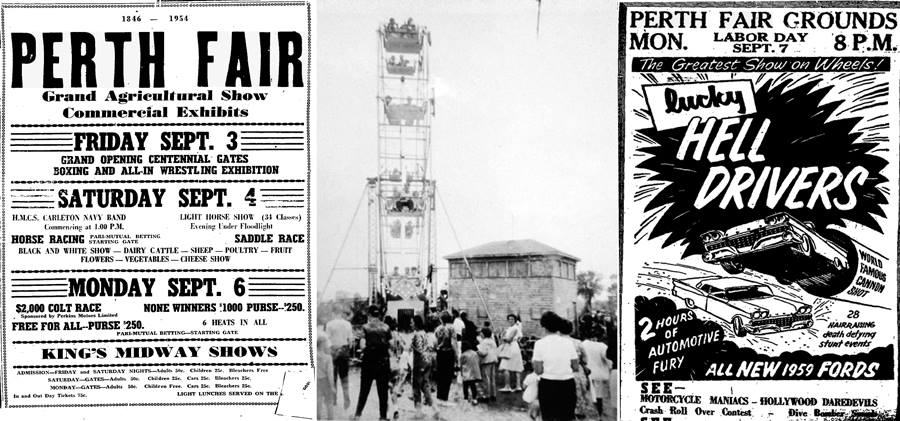
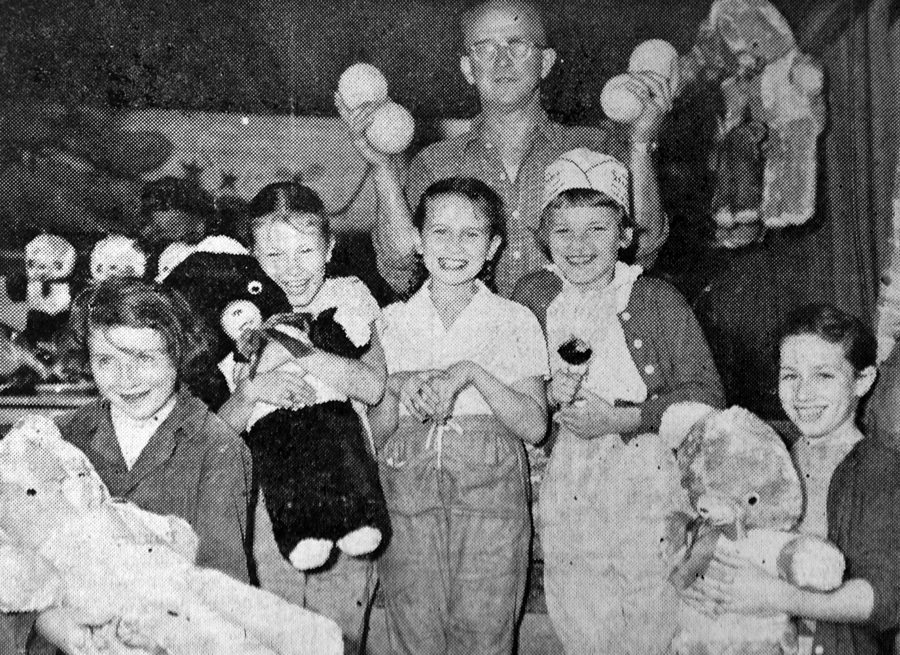
Looks like these young ladies had a great time at the Perth Fair in 1956. Left to right; Wanda Mahon, Bette Duncan, Mary M. Douglas, Marsha Ann Nichols and Heather Murphy with Bill Redman in the back, who ran the concession for the March Midway Shows.
THE TOWN HALL
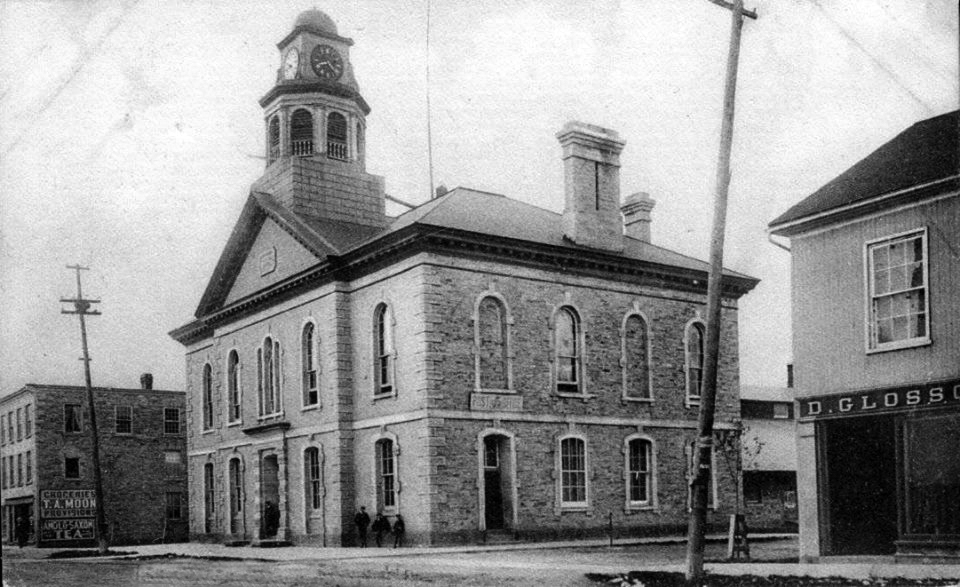
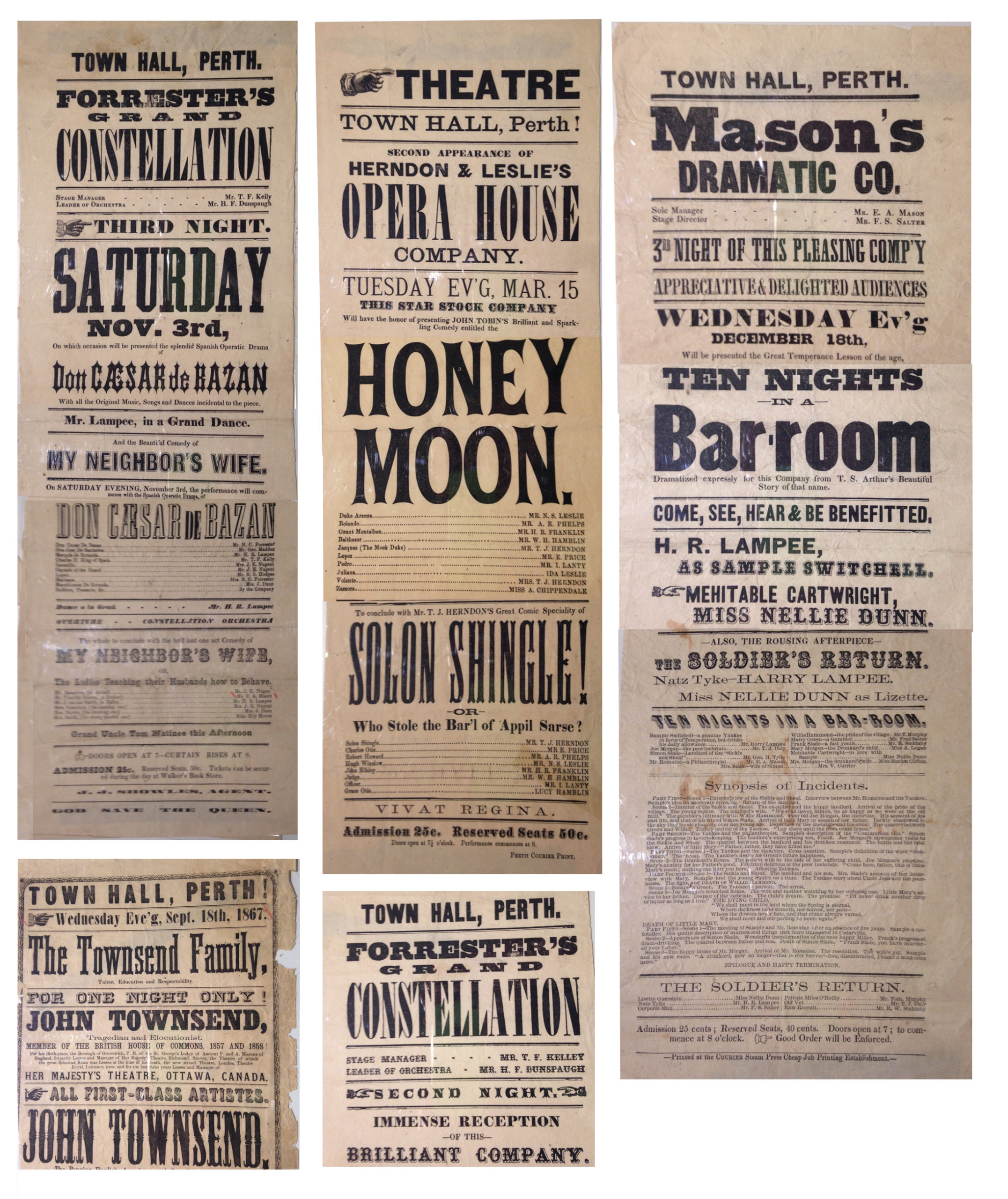
THE BALDERSON THEATRE 1915
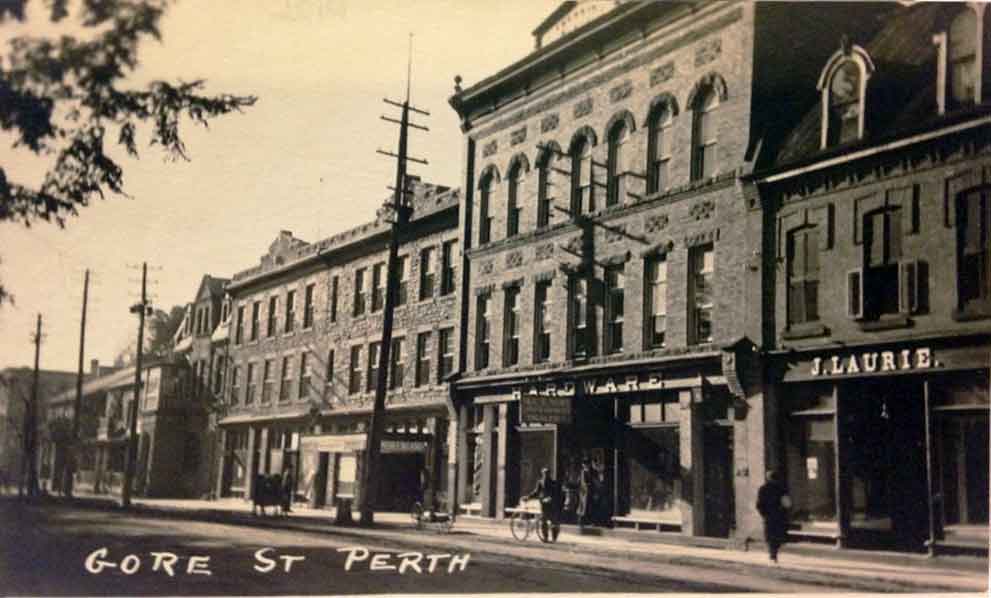
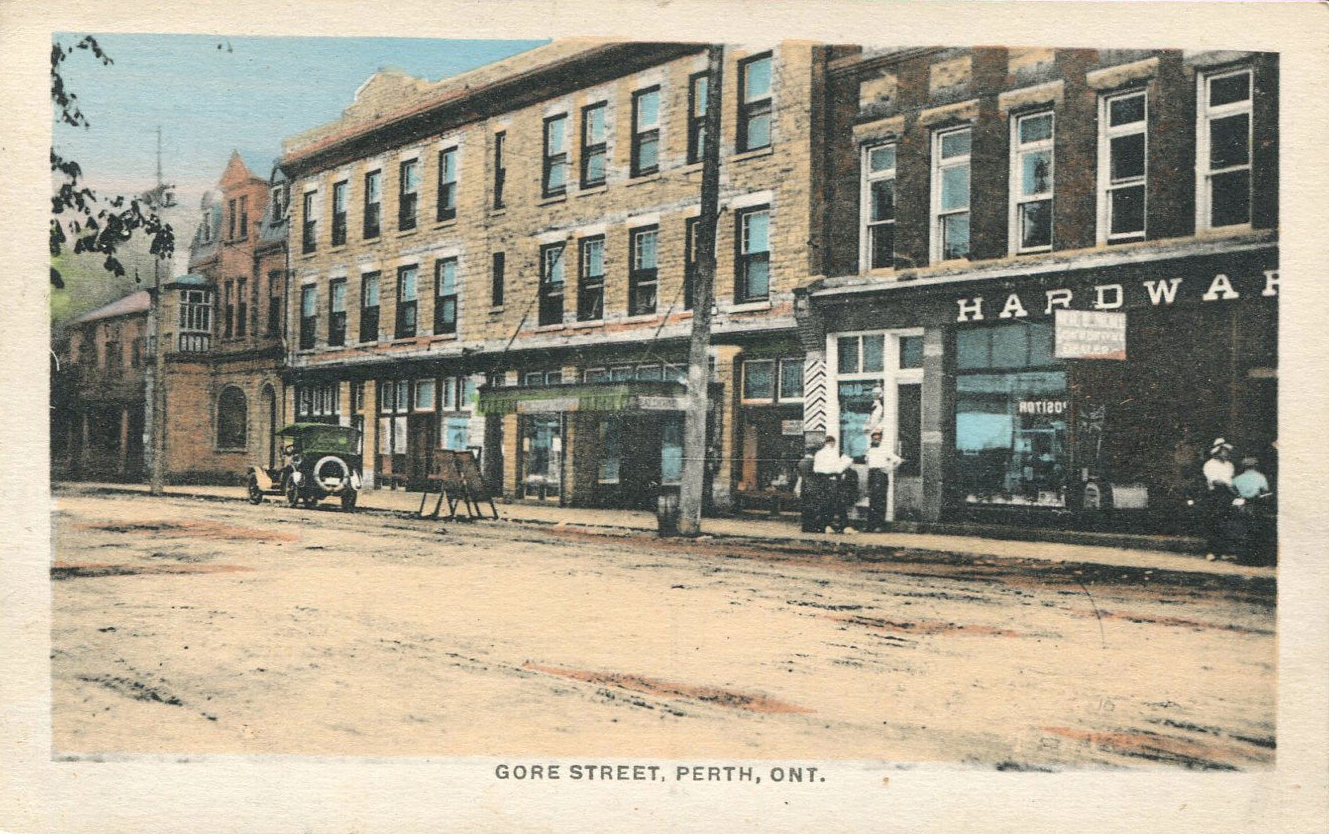 Colonel John Balderson purchased the old Starland Theatre, which was situated on the land where the Perth Post Office was built across from the Town Hall on Gore Street. The building was demolished and the stone transported up Gore Street to a vacant lot, where buildings were destroyed in a destructive fire December 1891, where the stone was used to construct the new Balderson Theatre. It was said that the 1,200 seat playhouse was build at a cost of $150,000. It was also said that Col. Balderson was also acting on behalf of some rather influential Perth families when he purchased the Starland Theatre.
Colonel John Balderson purchased the old Starland Theatre, which was situated on the land where the Perth Post Office was built across from the Town Hall on Gore Street. The building was demolished and the stone transported up Gore Street to a vacant lot, where buildings were destroyed in a destructive fire December 1891, where the stone was used to construct the new Balderson Theatre. It was said that the 1,200 seat playhouse was build at a cost of $150,000. It was also said that Col. Balderson was also acting on behalf of some rather influential Perth families when he purchased the Starland Theatre.
In 1915, George Walker opened a drug store on the premises on the new theatre building and following shortly thereafter a butcher shop also opened its doors. During the formative years of the Balderson Theatre, most of the entertainment had a home-grown flavour to it, with many of the productions featuring local actors and actresses from Perth and surrounding municipalities. Sell out shows like “Pretty Baby”, 1919, was advertised “that the happy go lucky atmosphere of this big syncopated musical treat provides the sort of entertainment which every musical loving community likes”. “Built like a miniature “Ziegfeld Follies”, without any palpable imitation thereof, “Pretty Baby” just rags and turkey trots from one frivolity to another.”
Before the moving picture phenonomen took the world by storm and captured the hearts and minds of theatre going audiences, Perth residents were treated to the sights and sounds of such diverse theatre entertainment as Broadway musicals, The Marks Brothers (who had a summer house at Christie Lake), the Dumbells, Guy Brothers Minstrel Show, Vaudeville Acts, indoor circuses and numerous locally produced plays. During the early 1920’s the world famous escape artist Harry Houdini appeared on the stage of the Balderson Theatre and completely mesmerized the capacity audience. Showmanship flourished in those days of live theatre and promoters pulled out every stop in order to captivate their audience. One stunt in particular gave Perth residents something to talk about for years after, when they saw a hypnotized man riding a bicycle in the window of the Courier office, while another lay prostrate in the window of Walker’s Drug Store.
Often as not there were days when no theatrical productions were presented at the theatre so Mr. Everett Kane, who spent nearly 15 years working nights at the theatre as a prop and scenery man, hand cranked a film projector for moving pictures. Silent movies proved to be a big attraction for theatre goer and films ran almost continually from 8pm to midnight, which necessitated nearly four hours of hand cranking and this was done as well by Mr. Kane’s brother, Fred. In order to enjoy the full effects of early films, music was incorporated into the action by employing local piano players. Laurence Consitt along with Gertrude McTavish were two locals who heightened the enthusiasm of the audience by playing a battle charge or bringing them near to tears with a love song.
By 1930, the era of the travelling road show, vaudeville acts and musical extravaganzas had been replaced by talking pictures and the theatre was renovated somewhat to accommodate this new form of entertainment and the Balderson Theatre became the Perth Theatre.
When movies were not shown Perth Collegiate held commencement exercises The boy scouts, church organization and other institutions also used the facilities. Over the years the theatre was managed by a number of individuals including George Keral who was the first and Col. Ned de Hertel, Bill Hamilton, Jack Allan, Arthur White and Ken Carter who was the manager of the theatre closed in 1958.
The movie house went out of business because of high overhead and low attendance because TV was just coming on the scene and no one was going to the movies. After the theatre closed the Beamish Store moved into the location from it’s original location at the Corner of Foster and Gore in the Meighan Block.
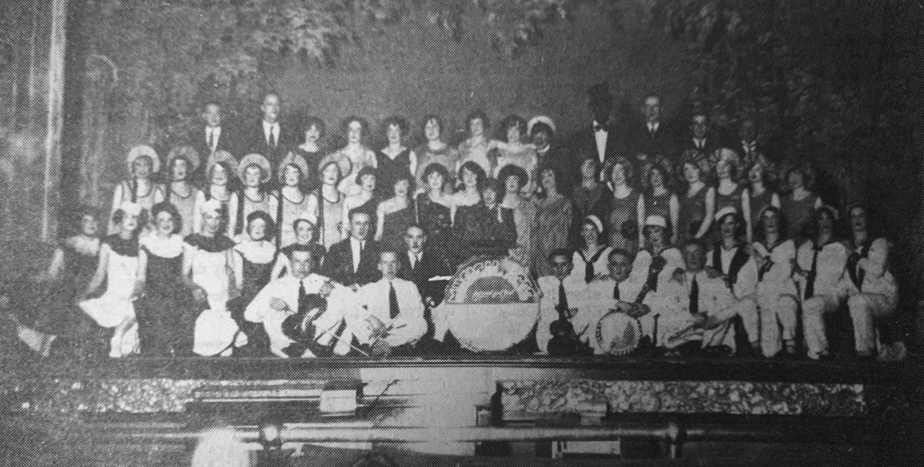
Guy Brothers Minstrels at the Balderson Theatre
MARKS BROTHERS DRAMATIC COMPANY
The Canadian Kings of Repertoire
Susan McNichol: Former Curator of the Perth Museum
There is a long and unique history of theatre in this town dating back to the mid 19th century. The era of the fabulous Marks Brothers is one of the most exciting stories in our colourful past. They have been called “the most remarkable theatrical family in Canadian history. The dazzling Marks Brothers were the greatest impresario performers of our small town stage in the era before the nickelodeon.” (Maclean’s Magazine, 1958.)
The Marks Brothers troupes performed all over Canada and the United States for fifty years from the 1870’s to the 1920’s. They delighted audiences in many remote towns and villages, most of them starved for entertainment, with their flamboyant performances and lavish scenery.
From the Courier Files:
The Marks Brothers travelling shows first came into existence in 1870 when Robert W. Marks, the elder brother attended a medicine show which was being held at a hall in Maberly. The star of that show was King Kennedy, who was billed as the ‘Mysterious Hindu’ from the Bay of Bengal. Unfortunately, he managed to draw mediocre crowds at the time Mr. Marks saw the show. Mr. Marks recognized the potential of the clever performer and decided that King Kennedy could make three times the gate receipts if properly managed. Mr. Marks proposed a partnership and from that humble beginning formed the foundation of the famous Marks Brothers that grew into four independent theatrical companies. In the early days the Marks Brothers played town halls and make-shift buildings that used barn lanterns for lighting. There were seven brothers, Robert, Tom, Alex, Jack, Joe, McIntyre and Ernie. There were also two sisters who were never on stage, Nell and Libby. Kitty (married to Ernie) and May A Bell (married to Robert) both performed with the brothers. Bob was a peddler when he first took to the stage, Ernie was learning the cheese making business. Tom abandoned his apprenticeship to a cobbler, Joe was within six months of his ordination into the ministry and Alex left the farm to follow in his brother’s footsteps. The two youngest brothers, John and McIntyre, went into the business for only a brief time. Neither could see a career in it and later McIntyre would find his own prosperous niche in the mining fields of British Columbia. They played mostly melodramas, but they could on occasion do good comedy. By the 1920’s time was running out for the Marks Brothers. When Ernie Marks began showing the silent film ‘The Great Train Robbery’ between acts he didn’t realize that the movies were going to kill repertory companies, vaudeville and all but the big time shows. One by one the Marks Brothers companies fell by the roadside and after they had said their closing lines, most returned to the Christie Lake farm of their boyhood. Robert remained on the stage until he was in his late 70’s and then he too retired to the farm. During this time he converted the rehearsal barn into a summer hotel and ran it until his death in 1936 at the age of 86. Joe wound up his company in the late 1920s then worded as an agent for a magician for a number of years before he too retired to the farm where he died in 1944 at the age of 82. Tom also went home to Christie Lake and turned the old house into a hotel and named it Arliedale, after his daughter Arlie. He died in 1935 at the age of 81 years old. In 1921 the influential Billboard Magazine echoed the sentiments of many when it stated, “The dramatic companies organized by the marks family have been the proud genesis of Canadian theatrical enterprise.”
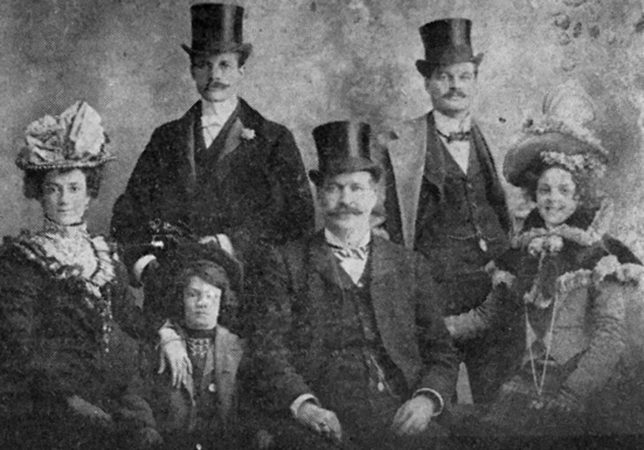
Left to right, front; May A. Bell marks, George Marks, R.W. Marks, Gracie Marks. Standing; Joe Marks, Alex Marks.
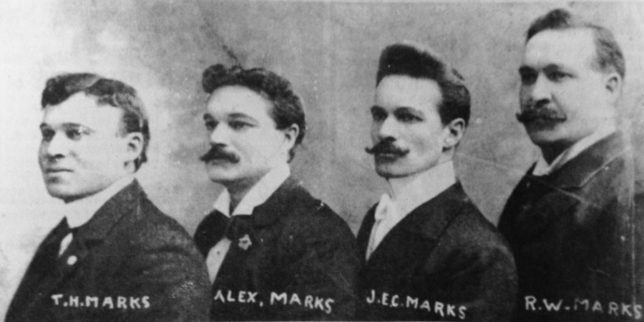
The dazzling Marks Brothers impressario performers brough an exciting world of theatrical villainy and vitrue to Canadian small towns early in the century before the heyday of the film era.
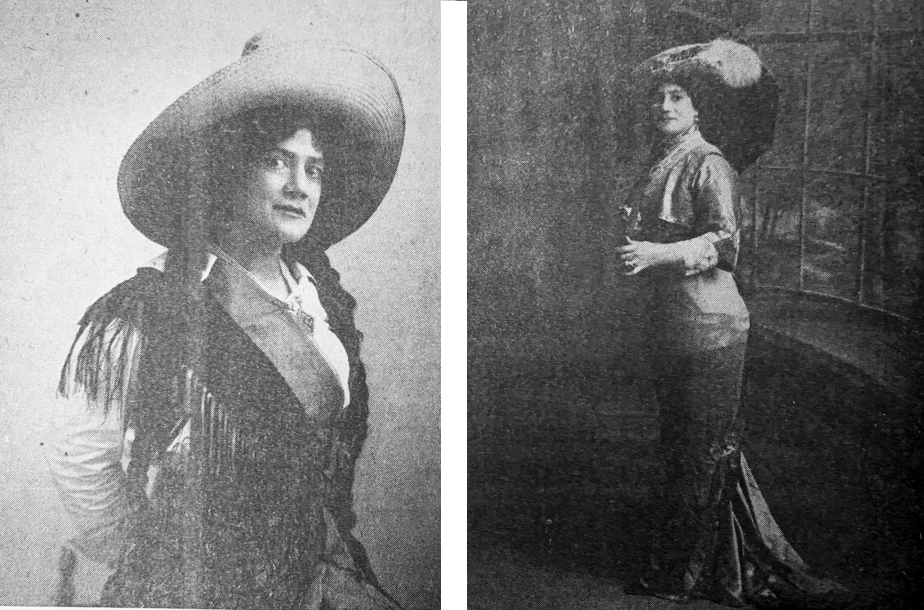
May A Bell Marks, wife of the well-known Robert W. Marks, and herself a member of the Marks Brothers theatrical company. Mrs. Marks is shown here in costume for two of the various roles which she played during the theatrical tours.
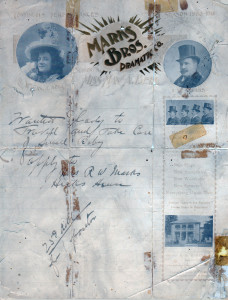
1900-1901 MARKS BROTHERS DRAMATIC CO. letterhead used to post this job application: Wanted, lady to travel and take care of small baby. Apply to Mrs R. W. Marks – Hicks House. Courtesy: David Bromley
Follow this link for more information on the Marks Brothers by Susan McNichol:
The Canadian Kings of Repertoire
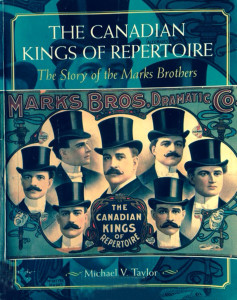
Read more about the fabulous Marks Brothers in “The Canadian Kings of Repertoire” – Michael V. Taylor
HAL BURNS ORCHESTRA
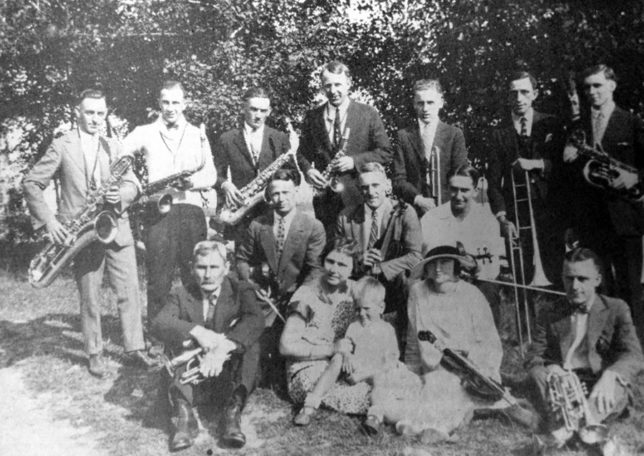
Orchestra group associated with the Perth Citizens Band, photo taken at Hal Burns’ cottage on Otty Lake during the 1920s. Front row: Bandmaster Alf Keays, Mrs. Hal Burns and son Bobby, Flo Cleaver, Caleb Strong. Second row; James Lunn, Howard Poole, Harry Gould. Back row; Miller Cameron, Bert Young, Earnie O’Heare, Hal Burns, Al Callely, Norman Lessard, Bill Brumbly.
THE CIRCUS COMES TO PERTH
CIRCUS AND MENAGERIE – JUNE 3rd 1853
The following account is from The Courier, Friday, June 3, 1853 in response to having to post an ad, shown here, in the newspaper.
One of those exhibitions of tomfooleries called a Circus, will visit Perth on the 18th inst. The mountebanks no doubt, twist themselves into all sorts of unnatural shapes, and cut up quite a variety of monkey tricks, for the particular edification of the natives who may attend. Of course there will be a large concourse of people, of different classes, assembled to witness the performances. For instance all the idlers and loafers will be there – all those who are not troubled with a super abundance of brains will be there – all the young men who desire to see females in bloomer dresses, riding on horses, will be there – all the modest young ladies who delight to see men in a state of semi-nudity will be there – many who cannot afford to pay for a newspaper will spend a quarter to be there – and a number of pious people will go to see the beasts in the cages, without looking at the monkeyisms in the arena. So that on the whole a large gathering may be expected.
We insert the advertisement of the exhibition, because it is a purely business transaction; and because, whether we do so or not, the Circus will be here, and people will attend it, and we may as well retain a few dollars or so for a license to exhibit within the limits of the Corporation. The Town Council will of course charge the Circus £25 or so for a license to exhibit within the limits of the Corporation.
We were requested to give the Circus a puff, and we have done so.
JUNE 14TH 1867
The Perth Courier, June 21st, 1867.
Bailey & Co’s Circus and Menagerie – by our own Reporter.
At an early hour on Friday morning, Perth presented a scene of unusual animation and bustle, scores of heavily loaded wagons and more pretentious buggies, with here and there a sort of two-wheeled equipage termed a gig, wended their way through clouds of dust, and by 9,30 o’clock several thousand people had arrived in town to see that wonderful sight popularly known as ‘the Elephant.’ which in the present instance was Bailey & Co’s Circus and Menagerie. Amorous swains and and loving damsels, benedicts and bachelors, matrons and maidens, small boys and little girls, happy in the expectation of soon beholding something extraordinary, perambulated the streets with admirable perseverance, and kept a sharp lookout for the appearances of the procession.
Entree Into Town
Before 10 o’clock, the music of the Brass Band was heard in the direction of the ‘Long Swamp,’ and in a few moments the first wagon, drawn by eight horses, and conveying the Hippopotamus, reached the Lewis House, and followed by fifteen immense vehicles, containing various sorts of wild beasts, proceeded through the town. The dust was simply horrible, but despite this disagreeable circumstance, a large crowned accompanied the procession in its course.
Preliminaries
The performance had been announced for 2,30 o’clock, and the interim was employed in erecting the Pavilion and making preliminary arrangements. One or tow “side shows” speedily got under way, and
attracted considerable numbers, who evinced a very laudable curiosity to witness the ‘melting’ sight of a sudatory “Fat Woman. ” somewhere in the neighbourhood of a quarter ton weight; and the “tall’ spectacle of a man ninety-five inches high. Pending the opening of the “Big Show,” the assembled masses dispersed in all directions, and anxiously awaited the hour at which the proceedings were to commence.
Slightly Crowded
Finally the time at which the outside world might enter the huge tent drew near, and in a short time every available seat was occupied, and many hundreds had to be content with standing room. As the day was exceedingly warm and upwards of three thousand persons were crammed closely together, it may well be imagined that comfort was entirely unknown, and indeed many were under the necessity of leaving.
The Menagerie
Placed in wagons on either side of the entrance, were the wild beasts; the collection, however, was not nearly so varied as most people expected. The hippopotamus, apparently almost overcome with the heat, came in for a fair share of attention; the lions, leopards, elephants, another smaller animals, were also viewed with no little interest.
The Circus
The athletic, gymnastic, and equestrian feats of the various performers, were quite equal to any ever before witnessed in Perth. The poses of the Australian Family, the splendid exercises on the Double Trapeze, and the daring horsemanship of James Melville, elicited frequent bursts of applause as hearty as it was deserved. the Trick Pony, the Comic Mules, and the Performing Elephant, all sowed a high degree of systematic training; and altogether the Circus proved a decided success, not only in a pecuniary point of view, but also in the general satisfaction it afforded to the vast assemblage both in the afternoon and veining. Early next morning the entire company departed for Smith’s Falls, in which classic village two exhibitions were given on Saturday.
Dead
Since writing the above we learn that the hippopotamus died when on the way to Kingston, in the beginning of the week. The poor animal appeared to be suffering even during the time of its stay in Perth, and many of the coguoscents, then declared that it would not survive for any length of time. Its live was insured for something like $3,000.
LEMON BROTHERS CIRCUS 1905
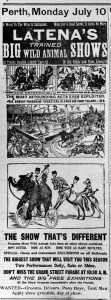 LA TENA’S WILD ANIMAL SHOW – Acts of thrilling and Sensational Character – 1916
LA TENA’S WILD ANIMAL SHOW – Acts of thrilling and Sensational Character – 1916
A big crowd attended the afternoon show. There are three rings in the big tent and as each is occupied with first-class artists, equal to those of the big shows, the eye of the beholder is kept busy taking in all the wonderful stunts. the trained elephants, lion, bears, seals, leopards and tigers were among the best ever seen here. One of the features was the high jumping horses in the world. Flying Joe, ridden by Miss Etta Myers with a record jump of seven feet and four inches, and Major McKinley, ridden by Miss Jess Nichols, his record being seven feet and two inches. The greatest thriller of the show was the dare-devil act of Mon. Morales who walked to the top of the tent on a wire down which he slid, falling to the ground while standing on his head. The trapeze work was of the best and the tumbling and contortion feats could not be excelled. the elephants proved a great feature in going through many marvellous feats. the Gothard trio gave a very creditable exhibition on a tight wire and Miss Morrall does the same on a slack wire. There was a whole retinue of clowns that were really funny. Cant. Pickard’s trained seals is claimed to be the greatest trained wild animal act in the world and very easily proved his right to the title. There were many other acts that were all excellent numbers. At the close of the big show a great exhibition of Wild West riding, lass throwing, rope spinning, riding bucking horses and many other features of the wild and wooly West is given. One thing chiefly noticeable was the respectability of the circus, all the employees conducting themselves in a very perfectly decorous and orderly manner. The tents and other equipment are all in first-class order and the costumes and other paraphernalia spick and span, adding wonderfully to the appearance of the show.
THE PERTH HARMONIC BAND-CITIZENS BAND 1852
The band has taken different forms over the years, called everything from the Sons of Temperance Band in 1852, The Brass Band to the Band of St. Patrick in 1856 and then the Fountain Engine Band in 1874 and for many of the years between 1898 and 1927, The Perth Harmonic Band. The Perth Citizens’ Band was actually a part of the 42nd Regiment (later the Lanark and Renfrew Regiment and the Lanark Renfrew Scottish). Even so, it has been known as the Perth Citizens’ Band since the 1880s.
On of the first accounts of the PERTH BRASS BAND was found in the Friday, February 25th edition of the BATHURST COURIER 1853. The Soiree of the Sons of Temperance came off in the Division Room on Tuesday evening. The Chair was occupied by Mr. S. Bothwell, W. P. The refreshments were good and supplied in abundance. The BRASS BAND discoursed most excellent music and the superior manner in which Mr. Fraser acquitted himself is worthy of particular mention. The Speakers were Messrs Shaw and Deacon and the Revds. Messrs Wardrope, Duncan and Bain. The names of the speakers are a sufficient guarantee that the speeches were good. The Soriree ,on the whole, came off well.
Friday, April 29, 1892 – The Perth Courier
THE HARMONIC BAND under the direction of Mr. C. J. Downy will open their Concert season next Saturday Evening at 8pm at the Hicks’ House square when the following programme of standard music will be rendered – Weather permitting. March, Triumphal – Mexican Valse, Sobre Las Olas, Concert medley, No. 1 – Beyer, Maggie Morphy’s House – Brachan. Selection, Remebrance of Bohemia – Faust, Valse Dream Faces (Vocal) – Josef Meissler, March, Boccaccio, 14th Andante and Waltz – Sir A Sullivan, Galop, Good Evening – P. Godfry. God Save the Queen.
Friday, July 1, 1892 – The Perth Courier
THE MASONIC EXCURSION. The excursion last Friday, on the Haggart, was the most successful on that ever left the basin. The number of tickets were limited so that there was just a comfortable crown on board. The Harmonic brass band and a string band enlivened the proceedings and dancing was indulged in at the park. Abundance of provisions was on board and everyone confesses to having a first class time. The county councilors enjoyed themselves immensely. True Britons’ lodge has got its name up for holding good excursions.
PERTH CITIZEN BAND 1910
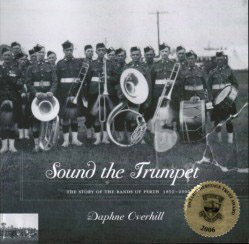 Sound of the Trumpet by Daphne Overhill
Sound of the Trumpet by Daphne Overhill
“A way of life as much as a way of music, the marching bands of Perth, Ontario have reflected the times of their town from the days before Confederation, making them one of the longest continuous musical presences in the country. In Sound the Trumpet, historian Daphne Overhill brings to life a rich pageant of band and local history. From the days of temperance through the real story of the original Music Man up to the new millennium, the Perth bands have interwoven their history with their community and maintained a musical tradition as important to the 21st century as to the 19th.”
Winner of the Ontario Heritage Trust Award in 2006.
The book is softcover format, 182 pages including photographs and is indexed.
PRICE: $25.00 plus $5.00 For shipping and handling
To purchase this book visit: Perth’s Citizen Band
HANK SNOW 1947
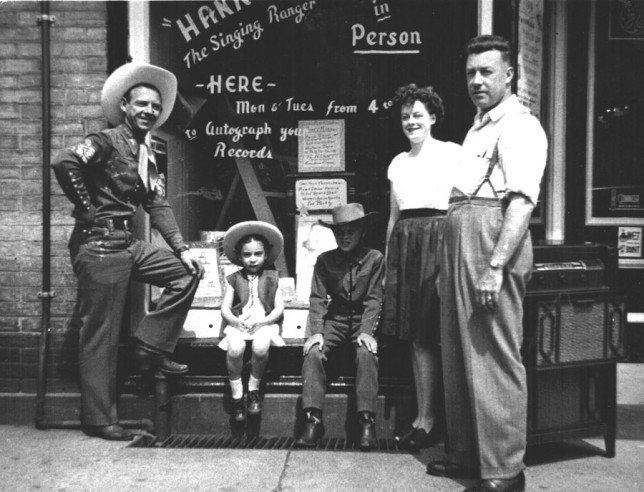
The photo shows Hank Snow to the left and Evie Moskos sitting beside Hank’s son, Jimmie Rogers Snow. Not sure who the woman is, but Bill Sawdon stands to the right. Picture taken in front of G.W. Sawdon Electric store. Hank Snow and his son Jimmie Rogers Snow were at the record department of Sawdon Electric to autograph records.
THE PERTH COURIER JUNE 1947 :Canadian Legion Brings Western Variety Show to Perth June 23-24
Under the auspices of the Perth branch of the Canadian Legion, folk from Perth and district will have an opportunity of seeing something a little different in the way of entertainment next week when a roadshow with a western accent hits town on the 23rd and 24th.
“Hank Snow”, billed as “The Singing Ranger” – star of RCA Victor and Bluebird records.” Heads an offering of a variety of western entertainment. “hank” will also star in a trick and fancy riding exhibition with his wonder horse. “Shawnee.” Also in the show are such stars as Pat Patreau and Rusty Keefer and their Santa Fe Trail Blazers who have appeared on an American radio network with the “Hayloft Hoedown.” Rosetta, the yodeling cowgirl, direct from Dallas Texas, is also with the show as are Hanks son Jimmie Rogers Snow, Arty Rhyno, the last named being described as “king of the electric Hawaiian guitar”, Ples Goons, “the funniest man of all times,” and “Rip and Zip” proclaimed to be an outstanding comedy team. The show, advertised to start at 8pm will be seen at the fairgrounds.
P.C.I GYPSY CHOIR 1908
The Harmony Boys 1930
Leader – Violin, Harry Gould, Drum, Gerry Geddes, Piano & Guitar, Carl McDonald, Banjo – Vocal, Jack Geddes, Sax, Chris Todd
THE MUSICAL ACES
THE HAL BURNS ORCHESTRA

This photo was taken at Hal Burns’ cottage on Otty Lake during the 1920s after 1925 when the family moved to Perth to open Burns Jewelers. Front row: Bandmaster Alf Keays, Mrs. Hal Burns and son Bobby, Flo Cleaver, Caleb Strong. Second row; James Lunn, Howard Poole, Harry Gould. Back row; Miller Cameron, Bert Young, Earnie O’Heare, Hal Burns, Al Callely, Norman Lessard, Bill Brumbly.
PERTH OLD HOME WEEK 1948

Musician of the Oldtimers’ Band. Front row, left to right; Al Stocker, Vic Ottman, Deb Oakes, Dick Mills, Caleb Strong, A. Delisle, Frank Cole. Second row, left to right; George Nichols, Bill Nichols, Fred Nichols, Don Cowie, Bob Nixon, John Turner, Ken Burns, John Howie, Vic Young. Third row, left to right; Hal Burns, Harold Keitel, Joe lark, Russ Griffiths, Frank Cowie, Garnet King, George Saunders, Harry Liscombe, Dave Hart.
STARDUSTERS 1948
1954
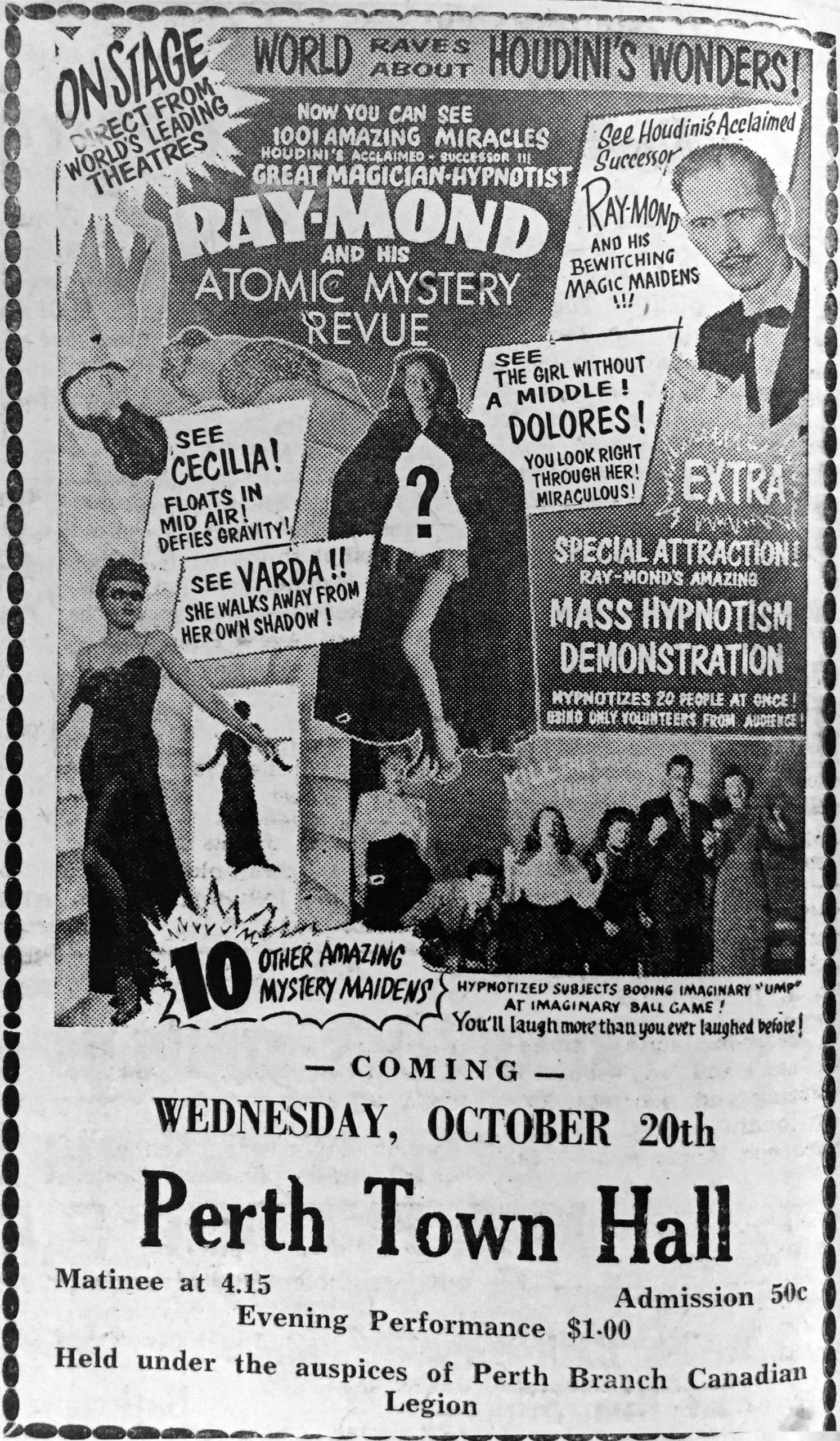
THE DIPLOMATS

Dancing to the “variety of modern melodies ranging from folk tunes to rock-and-roll and twist” performed by Perth’s Diplomats? Left to right; Fred Dixon, vocalist and lead guitar, Jerry Roberts, drummer, Bob Cox, rhythm guitar and Carman Knapp, bass guitar.
FRED DIXON & THE FRIDAY AFTERNOON
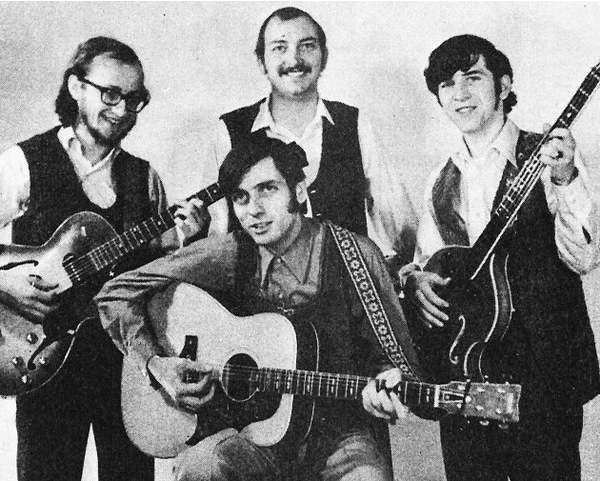
Left to right: Roger Plant, Sam Henry, Tom Valliquette and Fred Dixon in front.
THE WOOLIES 1966
“THE WOOLIES” MAKE A BIG HIT WITH TEENAGERS – The Perth Courier 1966
What began in a basement as a hobby for two young students, has grown into the most popular Rock’n’Roll and Go-Go group in Perth. The group is known as The Woolies and their music is what the young people of Perth want to hear.
The Woolies consist of four High School students, Peter Sabiston, 16, on the drums, Al Olsen, 16, and Ron Thornbury, 16, electric guitars and Greg Brook 16, playing the electric organ. The Woolies, just starting out as a group of four, make frequent appearances at local High School and Youth Club dances. Their current popularity and success can be attributed to their unique combination of drums, guitars and electric organ. It gives them something that sets them aside from the conventional pop groups.
All four boys take turns in the singing and there is not designated leader of the group. The group started in 1964 when Peter and Al got together and played “just for fun”. A few months later they were joined by Ron and then by Greg in December, 1965. After playing together for just over a year, The Woolies have become the best know pop group in Perth. But it was not without a lot of hard work and practice. The boys put in six hours of group practice every Saturday plus as many hours of individual practice as they can manage. But they still regard it as a hobby and really enjoy it. It is the combination of hard work, enjoyment in their work and a different musical sound that has given them their popularity. The Woolies hope to get more out-of-town engagements soon. They have already played at the Sharbot Lake High School. They are still a young group and it may not be too long before they make a name for themselves in the surrounding area.
JIM WHITE AND HIS ORCHESTRA c.1967

Great music at the Legion Saturday Night Dances and all across the area for many years. Thanks to Nancy Hudson who sent this picture in. Nancy writes: “This picture has hung in the Perth Legion for many years. My Dad , Jim White [front centre] and his band played for the Saturday night dances starting with the very first one 50 years ago until the early 1980’s. Also show are band members, Clarence Williams, Clarence Bowes (father of the Bowes Brothers]) and Sandy Stewart.” Ads along with photo from the Perth courier, 1969 and 1978.
THE COUNTRY ROCKETS 1964

Perth’s country and western music group, the Country Rockets, performed on the Ted Mack Original Amateur Hour Show in Watertown, N.Y. on the coast-to-coast U.S. television show. From left to right are; Ray Donaldson, Terry Donaldson, Bill Munroe, Wilf Newton and Bob Dowdall. Hidden from view behind Mr. Dowdall is Marjorie Munroe playing the bongo drum.
KIRBY LOVE AND THE THUNDERTONES 1970s

This Rock’n’Roll band was well known in Perth and had a large following in Lanark County. The band members, clockwise from left; Chip Smith (Dave White), Kirby Love (Paul Vallely), Eddie Martino (Martin Crawford), Spike Steel (Dale Murdoch) and Jack Offenbach (John Stephens).
DONKEY BASEBALL 1937
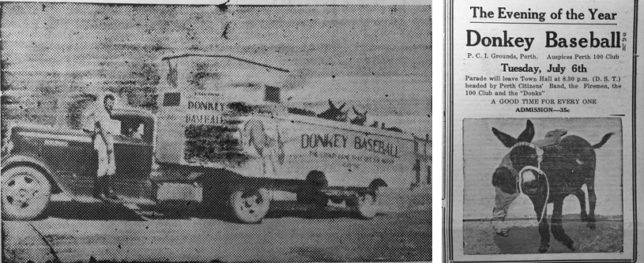
1948 P.C.I PRODUCTION OF H.M.S. PINAFORE
The citizens of Perth and vicinity were given one of the best musical treats in years when the Glee Club of the Perth Collegiate Institute presented Gilbert and Sullivan’s comic opera “HMS Pinafore”. Good houses greeted the players at each performance and they were thrilled from the first note sounded by the orchestra to the last fall of the curtain. It is difficulty to ascribe to any member of the cast special merit since all were so outstanding in the parts they played. Buttercup (Jean Anderson), the Captain (Graham Cameron), First Lord of the Admiralty (Douglas Hogg), one of the sailors (Huber Hosie), the Boatswain (David Code), a gruff salt (Douglas Smith), accompanist (Mavis Anderson), all displayed rare talent and gave a most creditable performance. Mr. Mills, the director is to be congratulated. From the many favourable comments it is believed that the people of Perth enjoyed this excellent musical comedy and will be looking forward to another Gilbert and Sullivan operetta by the Glee Club of the Collegiate.” The Chorus: Winnifred Briggs, Joy Cameron, June Campbell, Nancy Code, Margaret Conlon, Helen Dodds, Mary Hammond, Betty Izatt, Margaret Kane, Joyce Keays, Lorna Lochhead, Joyce McDougall, Helene Nixon, Dorothy Smyth, Olive Whillant, Lois Wilson, Eleanor Wark, Muriel Mills, June Code, Mary Doull, Janet Drysdale, Betty Horne, Norma Howie, Joyce Huddleston, Opal Lindop, Jacqueline Patteneden, Dorothy Reid, Madeline McGinnis. Boys: Fred Barrie, Lawrence Code, Edward Danner, Bill Hewitt, Arthur Knowles, Edward Stedman, James Strong, McKenzie Youngs, Ian Fraser, Eric Noonan, Godfrey Siddall. Photo by Perth photographer Newman.
